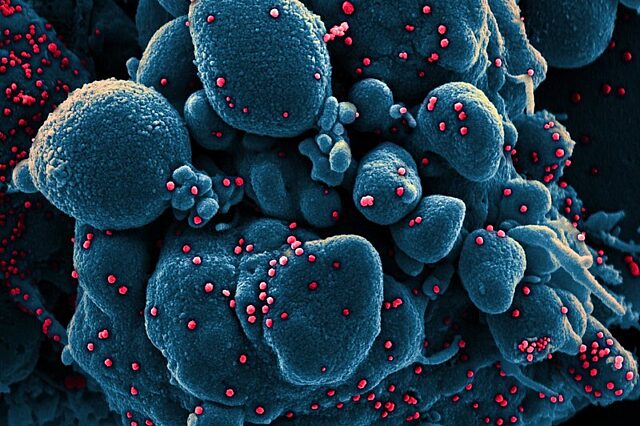Endemic COVID-19 could be one to 10 years away

If you donned your mask today and felt a primal urge to yell “When will this pandemic END-emic already?!” take heart. You are not alone.
On the eve of the second anniversary of COVID-19’s arrival in Florida, many yearn to go back to the way things were. We want to shed our masks and gather close — 2019 style, without fear.
But COVID hasn’t gone away entirely. In fact, experts say it’s here to stay. Which is why it’s still important to mask up, keep your distance, get vaccinated and stay boosted.
“We may feel over COVID, but COVID isn’t quite over us,” said University of Florida biostatistician Ira Longini. “We are coming out of the omicron peak a little more slowly than we projected, pretty much everywhere on the planet.”
Longini is an expert in modeling infectious diseases, vaccine efficacy and clinical trials. He has been involved in projects with collaborators such as UF research assistant scientist Thomas Hladish in the UF College of Liberal Arts and Sciences to estimate how different COVID viral variant surges will play out in Florida. Their models have tracked closely to real-world events. But researchers are still trying to understand what may happen next with omicron.
“Looking at some other countries, it’s not clear how far the curve is going to come down in Florida,” said Longini, a professor in the UF College of Public Health and Health Professions and the UF College of Medicine. “It may plateau at some point to a low-level endemic state and then continue like that.”
Longini said many factors could be at play in the prolonged omicron denouement, including changes in people’s behaviors, public health mitigation interventions easing, and schools opening in person. Even a recent cold snap, which caused Floridians to gather indoors more, could cause the virus to linger.
The subvariants of viral variants could also play a role. The advent of subvariant BA.2, which emerged from omicron BA.1, could be changing infection rates in Europe, Longini said. The new subvariant has been found in a small number of cases in Florida, although its ability to reinfect those who have had COVID-19 are unknown, as is its role in current transmission rates. Currently, we are not seeing more BA.2 in Florida, Longini said.
“The main thing people can do right now is get vaccinated and get boosted — all the way down to 5-year-olds,” said Longini, a faculty member of the UF Emerging Pathogens Institute. “And pay attention to your local conditions, to know when transmission rates are surging or declining.”
So, how do pandemics end? History shows us two paths. In one path, the infectious agent fades from humanity.
“We saw this with the 1957-58 Asian flu, the A/H2N2 strain, which disappeared from the face of the Earth and has not been seen since 1968,” said Longini. “SARS-CoV-1 has also disappeared from human populations since 2004.”
The second path is when pandemics burn through a population and then stay by continually reinventing themselves with minor variations. This is the path of endemism: They integrate into the suite of infectious diseases that co-exist with us.
“COVID is trying to find its way into the pantheon of respiratory viruses, but where does it fit?” Longini said. “Does it look like seasonal coronavirus, or does it look like influenza or respiratory syncytial virus, which is also known as RSV. It’s not done with us, but it’s trying to figure out its place, and it’s not going away.”
Longini estimates that it could take between one and 10 years for COVID to become endemic. Global disparities in vaccine distribution and acceptance could also further drive the emergence of new variants, he added.
“Some future variants may be mild, others more lethal,” Longini said. “There is really no telling.”
For now, COVID-19 is a year-round virus. But it may eventually become a seasonal threat, Longini said, similar to the mild coronavirus strains OC43, NL63, HKU1 and 229E, which we deal with most winters.
“It looks there will be a whole host of these coronaviruses that are all somewhat different from each other, and that will persist and co-circulate,” said Longini. “Right now, COVID is trying to find its niche. How can it coexist with its respiratory viral siblings? Eventually it must evolve in a way it can fit in and persist. Though it may take several years to reach the endemic state.”
In the meantime, as population-level immunity develops, Longini said COVID could eventually become a disease of children and the elderly.
“As people age and accumulate more and more immunity, they will be less likely to have severe disease from this,” Longini said. “Until they get very old and vulnerable through declining immune systems.”
So where does this leave us today? Unfortunately, no matter how many times you feel you have hit your COVID wall, it’s not yet endemic and there is still a place for mitigation, depending upon local conditions and your personal risk factors, such as obesity and diabetes.
“We are dealing with an infectious disease,” Longini said. “We can’t expect a good outcome without controls. We can’t keep reacting the way we have been in Florida, and let it get out of hand over and over again, because then the transmission becomes unstoppable, like a freight train.”